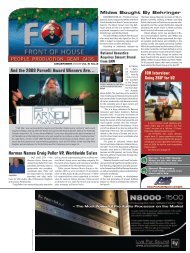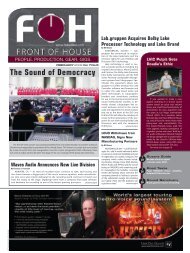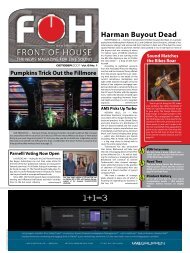Create successful ePaper yourself
Turn your PDF publications into a flip-book with our unique Google optimized e-Paper software.
Peavey Versarray 112<br />
We first saw the Peavey Versarray system<br />
almost two years ago, and have<br />
been trying to work out a road test<br />
ever since. As we have done with larger pieces<br />
of gear (including other line arrays) in the past,<br />
instead of having Peavey send out a rig for us<br />
to use on a gig, we went to a gig that had the<br />
system already on it and worked the show. In<br />
this case, that meant hooking up with Dave<br />
Albro, who is doing <strong>FOH</strong> and associated duties<br />
for the VIP events surrounding the current<br />
Tim McGraw tour. Most of the stops on the<br />
tour feature “side” events including local and<br />
regional acts, plus a VIP-only acoustic show by<br />
McGraw prior to the actual arena show, which<br />
is a Clair deal.<br />
The Gear rt<br />
Each cabinet in the array weighs in at 53 lbs.<br />
Construction is 13-ply Baltic birch. Drivers are<br />
a 12” neo Black Widow with a dual-4” voice<br />
coil and two ribbons to handle the highs. The<br />
specs say the box will go down to 100 Hz and<br />
you can put as many as 18 in a single array —<br />
although the system is really meant for small<br />
to medium venues, and you are more likely<br />
to see between four and eight boxes on most<br />
gigs.<br />
The rigging allows for full articulation from<br />
0 to 15 degrees between each box in 2.5-degree<br />
increments, which allows for a multitude<br />
of array-shape options. And a Versarrayspecific<br />
version of EASE is downloadable from<br />
Peavey, as are project presets for Versarray<br />
systems for the Peavey VSX 26 loudspeaker<br />
manager, which was used on this gig. All input<br />
connectors are four-pin Neutrik Speakons.<br />
For the larger of the two stages, Dave used<br />
a flybar and hung six boxes per side over three<br />
Peavey 218 subs. All amps were Crest (5200 series<br />
on the highs and 8200 series on the subs).<br />
For the smaller stage in the VIP tent, it was<br />
three-over-two with the top boxes “groundstacked”<br />
on top of the subs.<br />
One of the nice things about this system<br />
is that you have plenty of options for flying<br />
or stacking, and Peavey provides the gear<br />
to make it happen. If you need to fly a small<br />
listen to the amp and plug it back in<br />
again. PERFECT! Right out of the box it<br />
sounds just like his AC30. My sigh of relief<br />
could be heard around the world.<br />
The boys at JLH have also added two<br />
other features to help you if you need it.<br />
There’s a port on the side of the box. Removing<br />
the cover helps create more lowend<br />
if desired. Also, there’s a high-end<br />
roll off switch on the box. I didn’t need<br />
to use either of them — I just plugged<br />
it in and it worked great. It was a solved<br />
problem right out of the box.<br />
Without the guitar volume on stage,<br />
I was able to turn everything else down<br />
and now my stage volume is 88 dB at<br />
<strong>FOH</strong>. I can mix the service at our pastors<br />
desired level without having to sacrifice<br />
the quality of our sound. For a relatively<br />
small price tag, it’s the best solution I’ve<br />
run across for this problem.<br />
If you mix in a large church like I do or<br />
you have a small church, I would recom-<br />
system, you can get six boxes up to 13 feet in<br />
the air without worrying about Genie Lifts or<br />
chain motors. A crankable Vermette lift, available<br />
from Peavey, will do the job and fold flat<br />
to fit in the truck.<br />
The Gig rt<br />
I was invited to go hear the Peavey Versarray<br />
112 when the McGraw tour came to USA-<br />
NA amphitheater in Salt Lake City. I spent the<br />
day working with Albro on the Frito StyleSonic<br />
StageLine SL100 stage and the VIP Tent stage.<br />
(Side note: While this Road Test is specifically<br />
on the Versarray 112, Peavey and Crest Audio<br />
manufactured nearly all of the gear on these<br />
stages. This is a real turnkey rig.)<br />
I arrived just in time to help setup the<br />
SL100 and then fly the six boxes per side over<br />
three groundstacked 218 subs. I could easily<br />
lift a box and — unlike some more expensive<br />
systems — it was a piece of cake to array and<br />
to fly. Pins slid right in with a minimum of “adjustment”<br />
(isn’t that what you call the all to<br />
common act of shaking the array back and<br />
forth until the pin you are trying to insert lines<br />
up with the proper hole?).<br />
The band on the SL100 was a veteran<br />
country act with both male and female vocalists.<br />
The band was made up of a drummer,<br />
pedal steel guitar, bass and electric/acoustic<br />
guitar in addition to the vocalists. The audience<br />
ranged from about 500 to 2,000 people<br />
gathered around the stage where the performance<br />
took place two hours prior to the main<br />
show.<br />
The stage was near a beer garden, so the<br />
audience size varied quite a bit, and the system<br />
proved more than adequate for the coverage<br />
area. In fact, Albro had to keep the top two<br />
boxes and one of the subs per side turned off<br />
during the show. If he had not done this than<br />
the sound would have carried too far into the<br />
other areas of the amphitheater. The sound<br />
pressure level at 50 feet was exceeding 100 dB,<br />
so this system can keep up with loud bands.<br />
OK, the big question we all want answered…<br />
How does it sound? It sounds really<br />
good. Plenty of clarity on the top and tons of<br />
mend the AxeTrak to anyone. It flat-out<br />
rocks. They also offer the AxeTrak in a version<br />
for bass as well as a 3x12, 1x12 and<br />
bass cab with 3 6s and a 15. Jeff and his<br />
team did their homework on the AxeTrak<br />
and it really shows.<br />
JLH AxeTrak<br />
What It Is: Sort of a direct box for<br />
guitar amps. Sort of.<br />
Who It’s For: Anyone who needs to<br />
control stage volume without sacrificing<br />
tone.<br />
Pros: Small and easy to hide, Easy to<br />
use. Great tone right out of the box.<br />
Cons: You can’t create controlled feedback.<br />
They don’t make one for every<br />
instrument on the stage.<br />
Price: $399 (Factory Direct).<br />
www.fohonline.com<br />
punch on the bottom coverage and sound<br />
was consistent on both systems.<br />
I was very impressed with how the Versarray<br />
system worked and sounded. These musicians<br />
expected tour-grade equipment and a<br />
professional sound and they got it. Especially<br />
with the small size and myriad mounting options,<br />
I can see this system in schools, churches<br />
and other smaller venues both as a rental and<br />
installed. As the owner of an anklebiter company,<br />
I would heartily recommend this system<br />
to anyone that needs a solid, road-worthy system<br />
that is affordable and can be purchased<br />
from one vendor.<br />
Peavey Versarray 112<br />
What It Is: Compact line array.<br />
Who It’s For: Smaller sound companies<br />
trying to get into the line array<br />
game and smaller HOW-type installs.<br />
Pros: Solid construction, lightweight,<br />
easy to rig, sounds good.<br />
Cons: None.<br />
How Much: $1,599 per box MSRP;<br />
$1,749.99 for the Versarray 218 sub.<br />
Peavey Versarray 112<br />
JLH AxeTrak<br />
Road Test<br />
By PaulOverson<br />
2008 AUGUST<br />
27

















